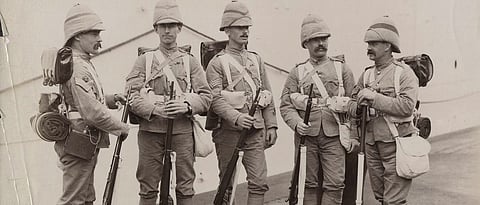

In 1848, when Brigadier-General Sir Harry Burnett Lumsden formed the Queens Corps of Guides, the first thing he did was to change the uniform. The tight-fitting scarlet uniform of the British Army, he decided, was unsuitable for the Indian climate, particularly the North West Frontier where he was posted. So he dressed his men in loose fitting clothes that blended with the landscape. The cloth used was coarse cotton impregnated with mud. Thats one version of the story. The other, more romantic one, traces its origin to the arrival of Hermann Gundert, the scholar grandfather of writer Hermann Hesse, in Malabar in 1839. Attached to the Basel Mission, Gundert is said to have been part of the group that introduced the Jacquard loom and fly-shuttle weaving in 1844. It was here that closely twilled linen cloth dyed in earth-colour (khak is Urdu for earth-dust) was created. By 1885, the British army adopted khaki as the preferred dress and colour of its troops. Its use spread fast and far the British used it in the Anglo-Boer Wars and the United States Army in the Spanish-American War in 1898. Soon, the cloth became the popular choice for outdoor gear and heavy working clothes. In 1986, Levi Strauss & Co turned it into a fashion statement when they introduced Dockers.
